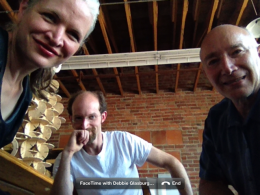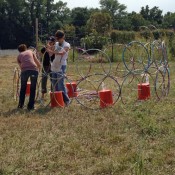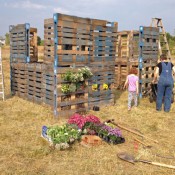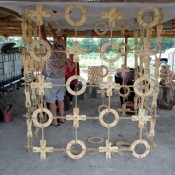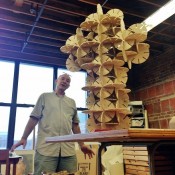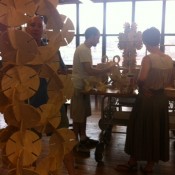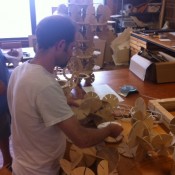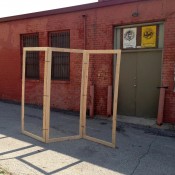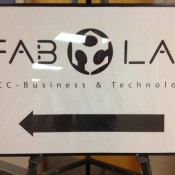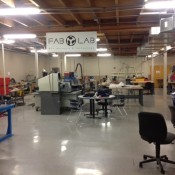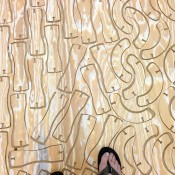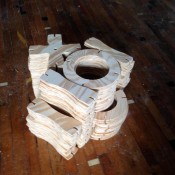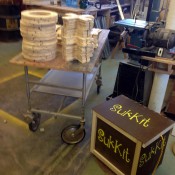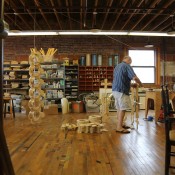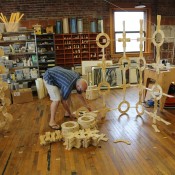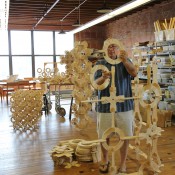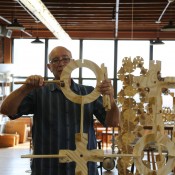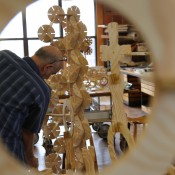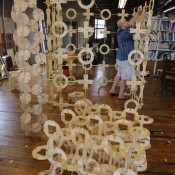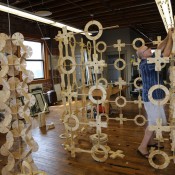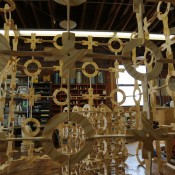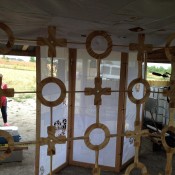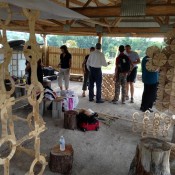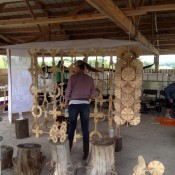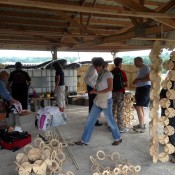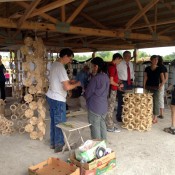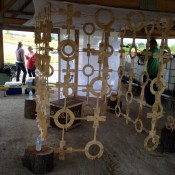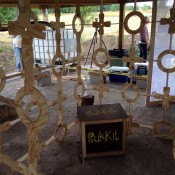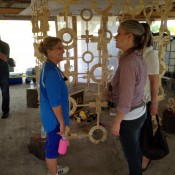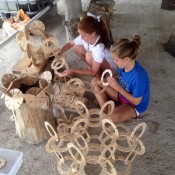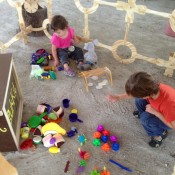Summer, 2013, Debbie Kaplan Glassberg recruited me to be “Lead Artist”, Sukkah Kit Team, ARTicipation: Abundance Garden Tasting & Sukkah Tour, The Kansas City Jewish Museum of Contemporary Art, Overland Park, KS. Debbie Kaplan once approached me with the idea of a kit sukkah and I replied with some simple sketches of plywood or plexi shapes outfitted with half-lap joints. Those could be easily assembled into numerous structural forms. Eventually, I let Debbie talk me into taking the lead on a team to design a sukkah kit of parts. At the organizational meeting I managed to recruit two others, Jo Kamm and Debra Smith to assist. Our task was to design and fabrication of a prototype kit for a Sukkah.
T
he Jewish fall harvest festival of Sukkot begins five days after Yom Kippur. Sukkot is the Hebrew plural of sukkah which means ‘booth’ or ‘hut’. Jews are supposed to dwell in the sukkah during the week-long celebration. Typically a Sukkah has at least three walls and a roof made of branches.
Jo Kamm is a budding juggler, 2007 ceramics graduate of KCAI, and 2010 MFA from Alfred University in ceramic art. He teaches 3D modeling techniques and has experience with computer aided manufacturing. Debra Smith is a well established fiber artist. She studied at the Italian Academy of Fashion & Design; Lorenzo de Medici in Florence Italy before receiving her Bachelor of Fine Arts from the Kansas City Art Institute with a major in Fiber in 1993 and an Associate Degree in Applied Science from the Fashion Institute of Technology in 2002. In 2012 Smith was honored as one of the Women to Watch 2012: Focus on Fiber & Textiles from The National Museum of Women in the Arts, Washington, DC.
Debra, Jo, and I met in my studio a number of times while we tried to reach consensus about how to realize out Sukkit. Consensus turned out to be elusive. Debra knew absolutely nothing about Sukkot, and although I’d gone to Jewish Sunday School as a child and had once seen a sukkah, I was very ignorant. Jo, on the other hand, turned out to be a knowledgeable expert having grown up spending nights each year in his conservative East Coast family’s sukkah. He recited the numerous rules for sukkah construction, and was a stubborn advocate for the most simple sort of ‘kit’ – 2×4 lumber and rope, for example, which, though inexpensive and practical, didn’t at all fire my imagination. I did produce a number of small kits of parts which would assemble into open rectangles per Jo’s folding screen ideas, and Debra has the most incredible sense of design – she quickly arranged the screens attractively. I CNC’d numerous interlocking parts from plywood and, of course, I liked these. Eventually, we failed to reach consensus and I just went ahead and cut a set of interlocking X’s I’s and O’s, enough to build a sukkah, plus a little rolling box to store and carry them. The four completed sukkah team results:
- ART team sukkah (hula hoops)
- ECO team sukkah (palets)
- KIT team sukkah (kit of parts)
- RECYCLE team sukkah (corn stalks and metal frame)
Debra and Jo went out to Metropolitan Community College’s FabLab, one of the places Jo teaches, and experimented with laser cutting several fabrics. The folded fabric the way you might fold paper to cut dolls, and Debra was enthusiastic with the results. She eventually pieced and sewed some huge fabric pieces, incorporating some of the laser cut fabrics and we draped the largest over the sukkah kit. I built some rectangular frames to Jo’s dimensions and Debra and I covered these to good effect with her fabric constructions, too. Jo wasn’t able to join us for the install near the Jewish Museum’s garden, but Debra and I erected the sukkah and other stuff pretty quickly. Here are some photos of our trials and errors and finished stuff…
- Mike with 45 degree slotted disk construc
- Jo Kamm and Carrie Riehl play with slotted components
- Jo Kamm brainstorming
- 45 degree slotted disk endless column
- Jo’s folding screen design realized in plywood and zip-ties.
- This way to FabLab
- Metropolitan Community College’s FabLab
- Jo Kamm working on laser cut fabric designs in FabLab
- Jo Kamm and Debra Smith collaborated on lasercut fabric
- unfolding the fabric
- some of Mike’s final parts for Sukkah kit – Sukkit
- Completed kit parts
- kit parts and their rolling storage chest
- Beginning to build prototype sukkah
- building first Sukkit in studio
- Build continues
- assembling Sukkit
- Carrie Riehl’s artsy documentation
- Almost done with building
- Prototype sukkah in studio
- sukkah in studio
- Debra’s fabric construction (with Jo’s laser cut panels sewn in) installed as folding screen
- A view of folding screen and Sukkit assembly
- Looking through Sukkit construction to folding screen with Debra Smith fabric construction
- People surround dense slotted disk table
- Debra Smith, rear view with fabric rooftop
- lots of slotted models
- people and constructions
- little slotted rings for kids to play around with
- Sukkit and screen completed
- Storage box included
- Debra Smith (r) reviews construction
- kids kinda enjoyed playing with slotted disks
- Sukkit as airy day care?
